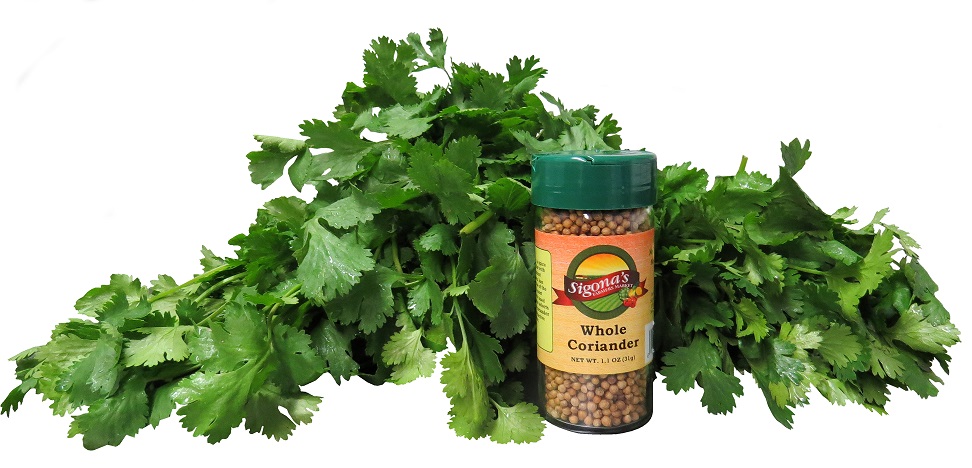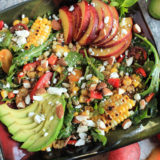Tips for Healthy Living: Healthy Herbs and Sensational Spices

Geri Wohl, CNC www.bettereatingcoach.com
Herbs and spices have been around since our ancestors early days. I have sometimes wondered how early humans figured out how to use certain parts of trees or plants to obtain specific benefits. Fortunately, we are the beneficiaries of their experimentation. Herbs and spices are used as flavor enhancers and home remedies; they have even been considered “medicines in smaller dosages”.
All herbs and spices originate from plants. They are classified based on the part of the plant from where they come. Herbs are the leafy part of the plant. They can be used either fresh or dried. Herbs are found wherever plants grow around the world. Spices, on the other hand, emanate from all other parts of the plant, including seeds, bark, roots and fruit. Spices are commonly dried and typically come from the Far East or the tropics. Some herbs and spices are even from the same plant. For example, cilantro, an herb, is the leaf and coriander, a spice, is the seed of the same plant. They exhibit varied flavors and are used differently in food preparation.
Spices and herbs are wonderful additions to the meals we create enhancing the flavor. Changing spices can result in an entirely different dish. We can even reduce our intake of salt, especially those needing heart-healthy foods, by flavoring with herbs or spices instead. This addition of flavor may also result in lower fat and sugar consumed in our foods. Keep in mind that spices are generally stronger than herbs so less is needed.
Spices are also being studied for their anti-inflammatory properties. As many diseases are inflammatory in nature, reducing inflammation is quite important. Spices may also help boost our metabolism, assist in calorie control and improve our overall diet. One spice, cinnamon, is known to support blood sugar regulation. Most spices are low in calories and high in B vitamins and trace minerals. They have even been found to possess anti-microbial properties.
In addition to the above properties, herbs and spices increase our intake of important antioxidants. For example, one teaspoon of ground cinnamon has an equivalent level of antioxidants as ½ cup blueberries or one cup of pomegranate juice. A food’s ORAC score measures the antioxidant potential of foods. Developed by the National Institutes of Health (NIH), ORAC (oxygen radical absorbance capacity) measures a food’s units of antioxidants. The USDA recommends that we consume a minimum of 3000-5000 units per day. Soil conditions, processing and species variety can affect these values. Diets high in ORAC scores are associated with decreased disease risk. For a listing of ORAC scores, go to http://oracvalues.com/sort/ORAC-value/. Keep in mind that these values are based on 100 grams of food. When looking at ORAC spice values, the quantity typically used is nowhere close to 100 grams. For more about antioxidants, see my article http://www.bettereatingcoach.com/7912-a-peach-a-day.html.
 So what’s the best way to have spices and herbs in our diet? Freshly harvested herbs will give the maximum benefit of antioxidants and other nutrients. For instance, fresh garlic has 1.5 times the antioxidants as dried garlic powder. In addition, herbs typically have a variety of antioxidants all working synergistically. We can obtain more types of antioxidants by consuming a variety of herbs. Six herbs with the highest levels of antioxidants are oregano, sage, peppermint, thyme, lemon balm, and marjoram. The highest antioxidant-containing spices or dried herbs are cloves, allspice, cinnamon, rosemary, thyme and marjoram.
So what’s the best way to have spices and herbs in our diet? Freshly harvested herbs will give the maximum benefit of antioxidants and other nutrients. For instance, fresh garlic has 1.5 times the antioxidants as dried garlic powder. In addition, herbs typically have a variety of antioxidants all working synergistically. We can obtain more types of antioxidants by consuming a variety of herbs. Six herbs with the highest levels of antioxidants are oregano, sage, peppermint, thyme, lemon balm, and marjoram. The highest antioxidant-containing spices or dried herbs are cloves, allspice, cinnamon, rosemary, thyme and marjoram.
Growing fresh herbs is easy to do and is a great way to involve our children in appreciating what the earth provides. Ensure a sunny spot that is well drained for your herb garden. You can even grow pots of herbs on a sunny windowsill. When storing fresh herbs, loosely wrap them in a damp paper towel and then seal in a ziplock bag. They will usually keep refrigerated for about 5 days. Herbs can even be frozen to lengthen their useful life.
Sometimes, fresh herbs are not possible. During the drying process, water is removed concentrating the flavor of the herb. However, some of the antioxidants will be lost. In addition, dried herbs and spices don’t last forever. They typically lose their potency after one year. Store dried herbs and spices in a dark place away from moisture. A good way to assess whether your dried spices are still effective is using your senses. They should look, smell and taste like fresh herbs.
When cooking with herbs, heat inactivates many of their beneficial qualities. For fresh herbs, it is best to add them near the end of cooking. This is especially true for more delicate herbs like basil, dill and parsley. Heartier herbs such as thyme, rosemary and oregano can withstand a bit more heat. Dried herbs can be added earlier in the cooking process, as it takes longer for their flavors to be released. As dried herbs are more concentrated, you probably only need to use ¼- ½ teaspoon of ground dried herbs compared to 1 tablespoon of fresh herbs.
For some delicious recipes using herbs, try my thyme salmon with verde sauce at http://www.bettereatingcoach.com/recipe-spring-2013.html or chicken squash stew at http://www.bettereatingcoach.com/recipe-fall-2012.html. Experiment with some new spice combinations. You may be pleasantly surprised!
© Geri Wohl, CNC











Nice content! Very informative and well written! I so learned a lot from this! Thanks for posting!